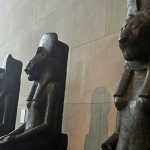By now you probably know that I am an unrepentant fan of Scarlet Imprint, publishing house of fine occult books. For my birthday at the beginning of June, my husband gifted me with Serpent Songs, a collection of essays whose central theme is traditional witchcraft. I squeed with delight. The book is beautiful to behold, as I expected. The textures of the paper feel good in the hand; the color and printing are a delight to the eye.

That said, I found this collection to be very hit and miss. Several of the essays I loved. Some I found entirely uninteresting. One essay in particular made me so upset that I wanted to hurl the book across the room. And not in ‘intellectually stimulated and challenged’ upset sort of way.
Let’s start with the awful and get it out of the way. Shani Oates, Maid of the Clan of Tubal Cain, has written a bloated essay in the purplest of prose. I read it three times, hoping that it was me and not her. Alas. Ms Oates writes as though she has mined a thesaurus for the most beautiful words she can find. There are lovely phrases, yet nothing seems to have any meaning. I suspect that she may have been writing in code. Many Craft practitioners do this, so as not to reveal secrets or break oaths. But some authors, like Serpent Song‘s editor, Nicholaj de Mattos Frisvold, are gifted at both writing in code, yet giving non-members plenty to chew on without condescension. Ms Oates essay reeked of outsider exclusion. Given that Scarlet Imprint writes for the smart occultist, without an emphasis on a particular tradition, I am stumped as to how this essay was included.
There are also some rather dull essays, ones I thought only marginally interesting. They reminded me of things I read in graduate school. I thought they might have been more at home in a decidedly academic collection.
But then there were several essays that more than made up for the others. I enjoyed Johannes Gårdbäck’s essay, ‘Trolldom.’ It’s a subject I don’t know much about. Gårdbäck, a Swede, used the tale of assisting a couple to inform the reader of many aspects of Trolldom, Swedish folk magic. It was interesting story telling and informative, too.
Several of the essays are ones I will come back to again. I was particularly impressed with the two contributions from Basque sorcerers, Arkaitz Urbeltz and Xabier Bakaikoa Urbeltz. This is a tradition I knew nothing about until reading these two essays. The way the home and hearth are central to their tradition, way of life and understanding of their world spoke to me in a deep way; I related and felt challenged to think more deeply about connection to home and place. One essay discusses Mari, a goddess I had heard stems from the Basque tradition, and is only found outside of it in the Feri/Faery tradition I practice. I felt these two authors did a beautiful job communicating their beliefs and practices in poetic, yet clear ways.
Sarah Lawless contributed a beautiful article on the ‘Mysteries of Beast, Blood and Bone’ which ends the volume. It is animistic in tone and practical in focus. It was a delightful ending to a mixed bag of essays, ranging from incredibly annoying to boring to possibly practice altering to profound.
Overall this book is, as are all Scarlet Imprint’s tomes, for the serious collector or practitioner. This book contains some of the worst writing I’ve yet to see them publish and some of the most beautiful and interesting. As always, there are several versions of this text, finely bound and digital.















